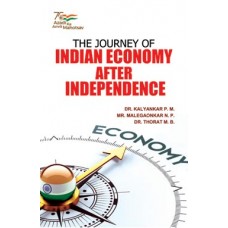The Journey of Indian Economy After Independence |
Author :
Dr. Kalyankar P. M., Mr. Malegaokar N.P. & Dr. Thorat M.B.
ISBN: 9789391844349
Year: 2023
Pages: 348
Binding: HB
Publisher Name: Serials Publications Pvt. Ltd.
ISBN: 9789391844349
Year: 2023
Pages: 348
Binding: HB
Publisher Name: Serials Publications Pvt. Ltd.
Price:
Price in Dollar: $60
INR 1,800.00
Price in Dollar: $60
Qty:
India became independent on 15th August 1947. After independence, India adopted a mixed economy. Indian Government emphasized the development of various sectors through planning. The Growth rate of Indian Economy, which was close to 2 to 3 per cent at the beginning of the planning period, it increased up to 8 per cent in the Eleventh Five Year Plan. Emphasis was laid on the development of various sectors of the economy through the Five-Year Plans. In the last 75 years, the economy has made great progress in the agriculture, industry and services sector. During the drought period of 1972 our country had to import large quantities of food grains, and now as a result of Green Revolution, we are producing large quantities of food grains in our country. The Country which was importing machinery to build large dams is now earning revenue through launching satellites of other countries due to technical progress. Subsequently the per capita income is reached from Rs. 265 to Rs. 150326 on current prices and India is the world’s 3rd largest economy by the Purchasing Power Parity.
Despite the progress made in various sectors some problems like poverty, inequality and unemployment have not been completely eliminated. India is completing 75 years of independence. Therefore, it is necessary to discuss the progress made in various sectors of the economy in this long period and the various problems that are being faced by these sectors.
Various programs and activities have been organized on the occasion of ‘Azadi ka Amrut Mahotsav’ by the Government and various organizations all over the country. Our college, which provides higher education facilities to students in rural area, is also completing 25 years of its establishment. To celebrates these two occasions, the Departments of Economics and Commerce of the College has jointly organized a National E-Conference on ‘The Journey of Indian Economy after Independence’ on 25-26 May,2022. We have invited the research articles from Academician, Teachers and Research Scholar from all over the country on ‘The Journey of Indian Economy After Independence’ in particular Sectors of Economy. We got tremendous response for this National E-Conference. Nearly 150 participants registered on the Google Form created for conference registration, while more than 80 participants have sent their research articles. Out of the articles sent by the participants for the conference, 38 articles have been published in this book.
The first eight chapters (articles) of this edited book ‘The Journey of Indian Economy After Independence’ analysed important factors related to the Indian Economy. The first article explains the pre-independence and post-independence trends of the Indian Economy, while the second article analysed the India’s Position in Commercial Services Trade. Some of these articles explain the progress of a particular industry in the Indian Economy. The contribution of Software Industry in the development of the Indian Economy has been explained in one of these articles, considering the importance of the progress of this industry in the Indian Economy in modern times. In one of these articles foreign remittance has been highlighted in recognition of the importance of Non-Resident Indians (NRIs), along with foreign investment.
The development of a country is for the peoples of the country and the process of development is done through the peoples. India's increasing population should not be seen as a problem but should be seen as an opportunity for the progress of the country in the form of working population. Article 9, Articles 11 to 15 of this book analysed various factors related to India's population. These articles analysed India's population growth, women's empowerment, child development, human development and the issue related to the Transgender Population.
Agriculture is considered as the backbone of Indian economy. Although the share of agriculture sector in the GDP has declined, the working population of the country is still largely depends on this sector for employment. Articles 18 to 20, Articles 24 to 33 of this book analysed various factors related to agriculture sector. In these chapters the writers have analysed the post-independence growth in agricultural production of India , the progress of Agro-Based Business and Agro- Processing Industries. Through these chapters the writers have not only analysed the problems in the agricultural sector in India but also analysed the new changes in agricultural marketing such as farmers' producer companies.
India accepted Globalization in 1991, one article in this book analysed the impact of Globalization, and some articles explained the increase in FDI inflows in India after Globalization. The role of entrepreneurship in the development of a country is important, an article in this book also analysed about entrepreneurship. It is necessary to sell goods produced and services generated from various sectors of the economy, for that the advertising and online commerce has an importance, last two articles of this book have highlighted these two factors.
The Indian economy has made significant progress in various fields, in 75 years after independence. In this book we have included several articles analysing the trends of various sectors of the economy, based on the response received from writers across the country. The size of the Indian economy is large and the three major sectors of the economy have many sub-sectors. Therefore, we have not been able to include the articles analysing the progress in all sectors of the economy in the last 75 years after independence in this book.
Write a review
Your Name:Your Review: Note: HTML is not translated!
Rating: Bad Good
Enter the code in the box below:




